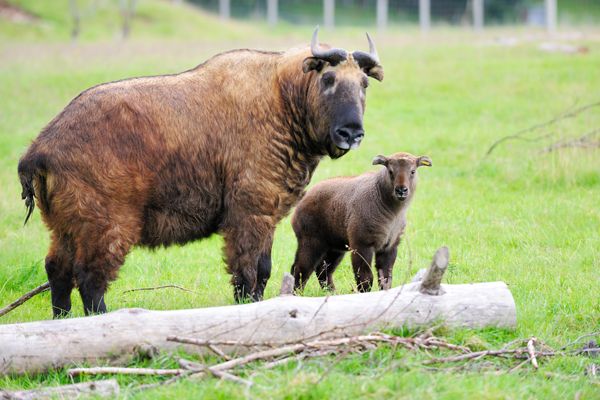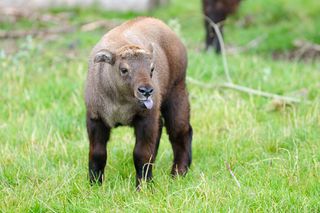
This New 'Hobbit' Won't Be Small For Long

The Mishmi takin herd at the Highland Wildlife Park has welcomed a new arrival, a male calf called Hobbit, the zoo announced today (Aug. 1).
Born to mother Cava and dad Raci, this Mishmi takin is the first calf to be reared in the Highland herd since 2010.
True to his name, the calf is easy to spot due to the gulf in size difference between him and the adults and his 2-year-old siblings. He also has a white band of hair across his forehead where his horns will eventually be.
At just 20 days old, Hobbit is still staying close to mom, but has more recently been exploring the enclosure solo. Takin calves can follow their mothers just one day after birth over a whole host of different terrain.
Stocky and surefooted, these animals are natives to Bhutan, Northeast India, Northern Myanmar and the neighbouring border areas of China in the Eastern Himalayas and they can be found living at heights of up to 14,000 feet (4,500 meters). These large goat antelopes were thought to be related to the musk ox of North America and Greenland due to some physical similarities, but genetic research has shown that they have no close relatives.
They have thick, brown, shaggy coats, and the golden "wool" that appears on the backs of mature males is believed to possibly be the foundation of the mythical 'golden fleece.' Interestingly, these animals produce a strong smelling oily substance that covers their coat to create a natural raincoat. They also have a secondary thick woolly coat that keeps out the wind and chill – making them perfectly suited for the Scottish Highlands!
"Noteworthy in particular is their moose-like long muzzles, that helps warm the air that they take in when breathing before it reaches their lungs. Without this they would lose a large amount of body heat just by breathing," said Douglas Richardson, animal collection manager at the park.
Sign up for the Live Science daily newsletter now
Get the world’s most fascinating discoveries delivered straight to your inbox.
Due to their size and muscular strength these feisty animals' only predators are tigers, leopards and possibly bears, although they now find themselves under threat in the wild due to hunting for meat, the traditional medicine trade and habitat loss.

"From a conservation perspective, the Mishmi takin is listed as endangered and the European breeding programme, which is managed by staff from the Highland Wildlife Park, may be of increasing importance given the pressures upon the wild population," Richardson said.













